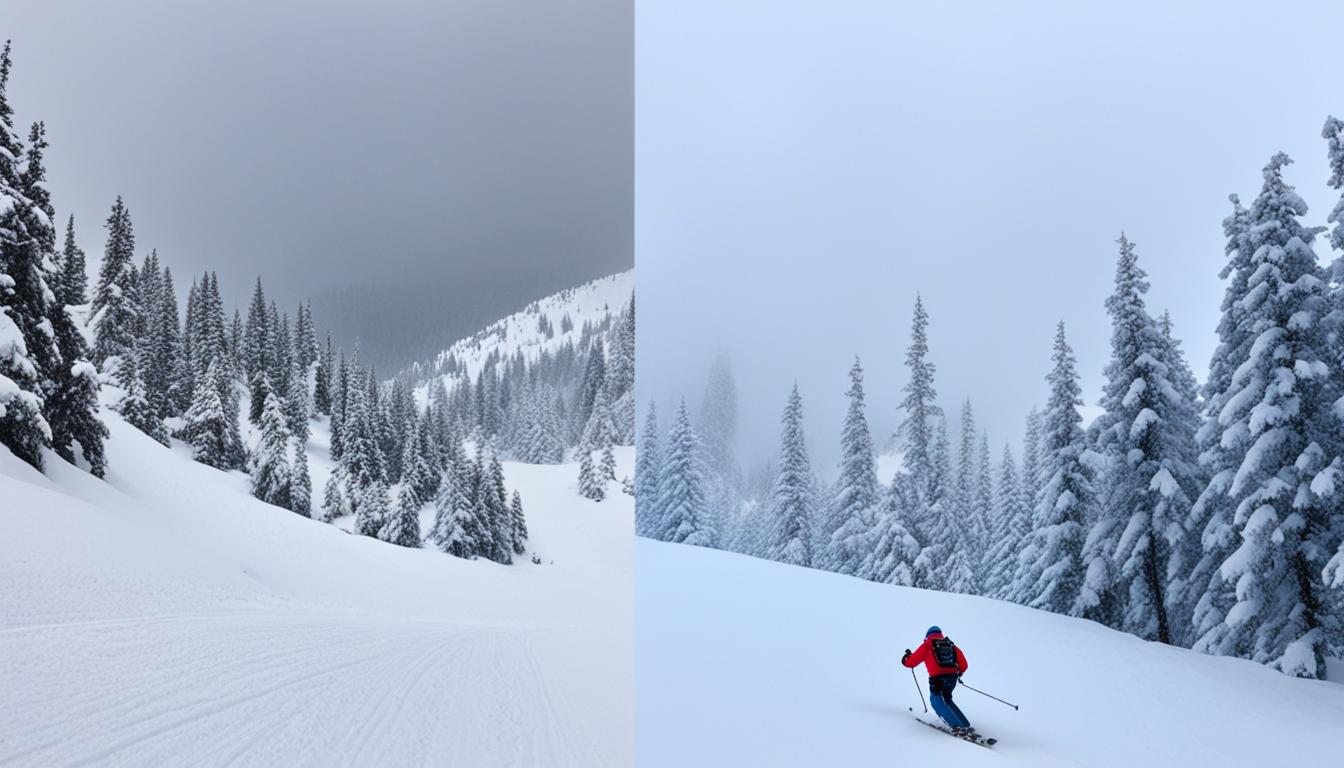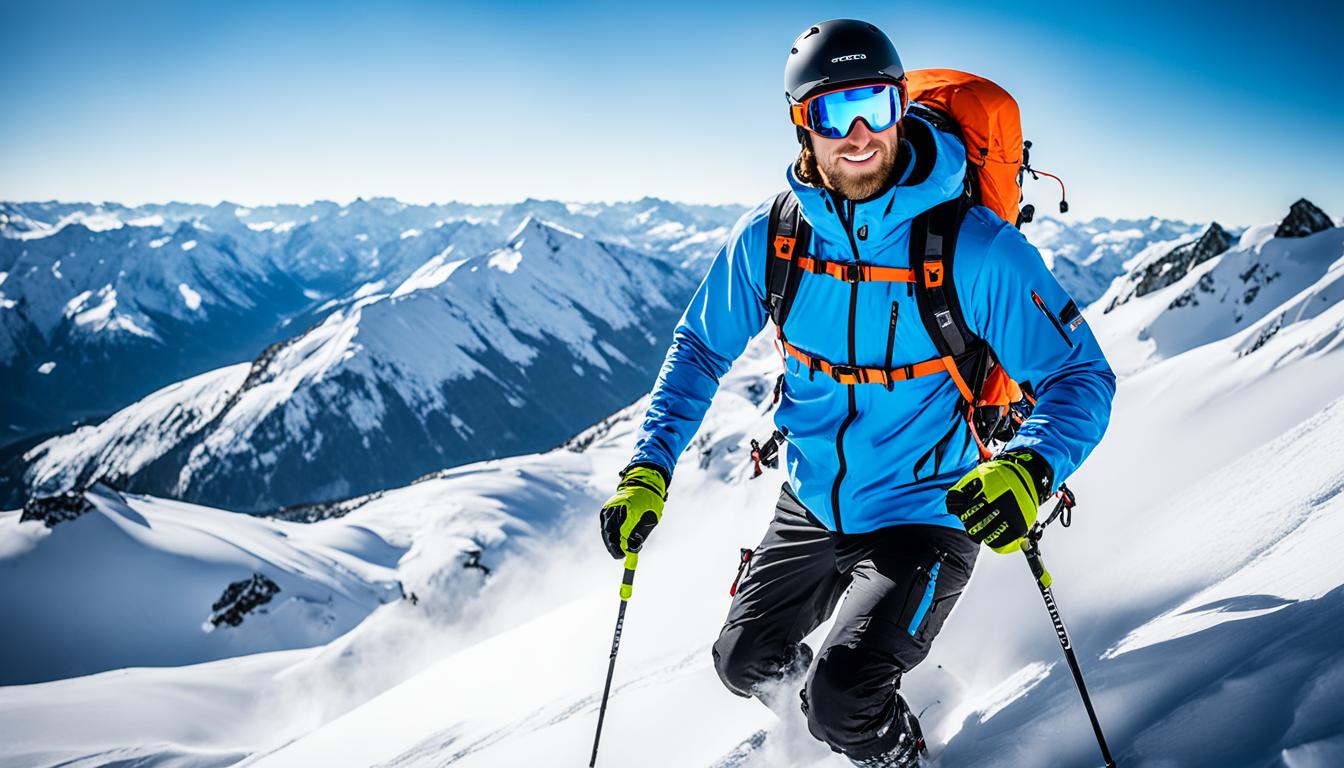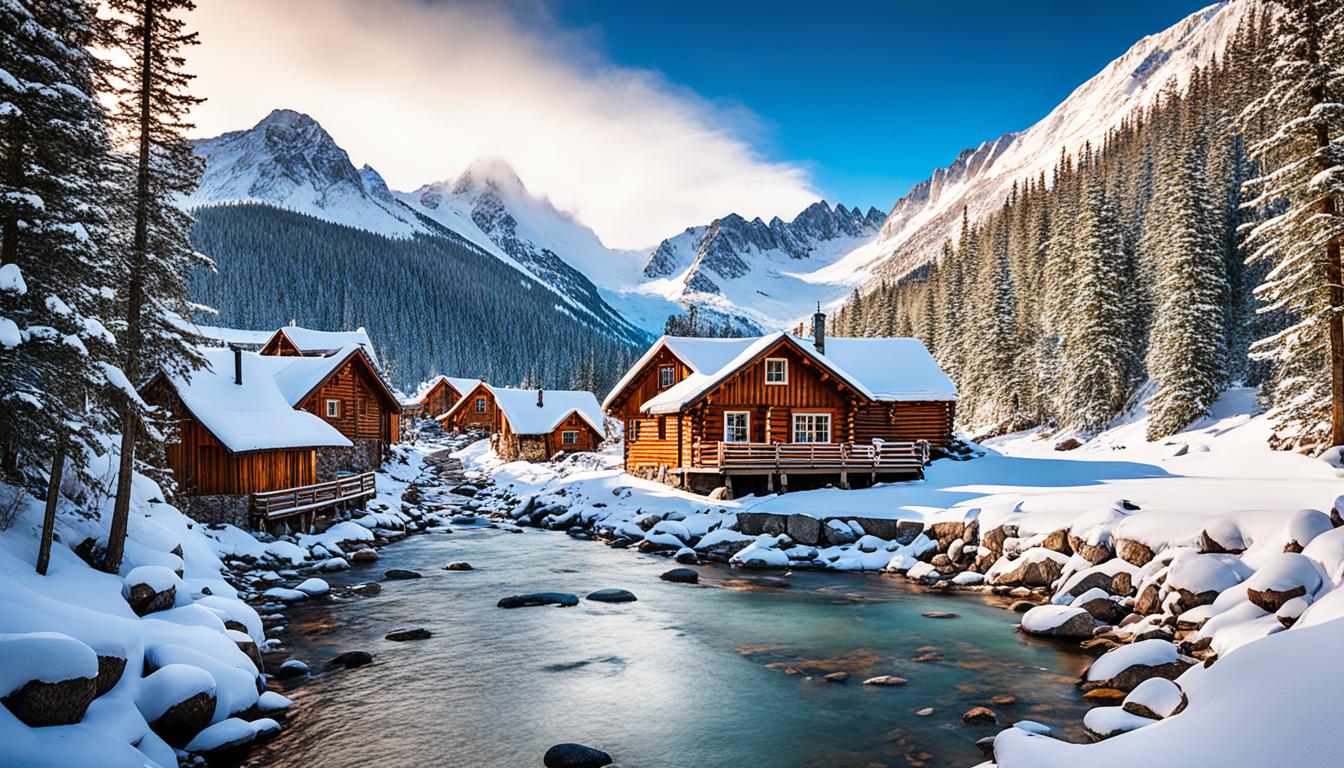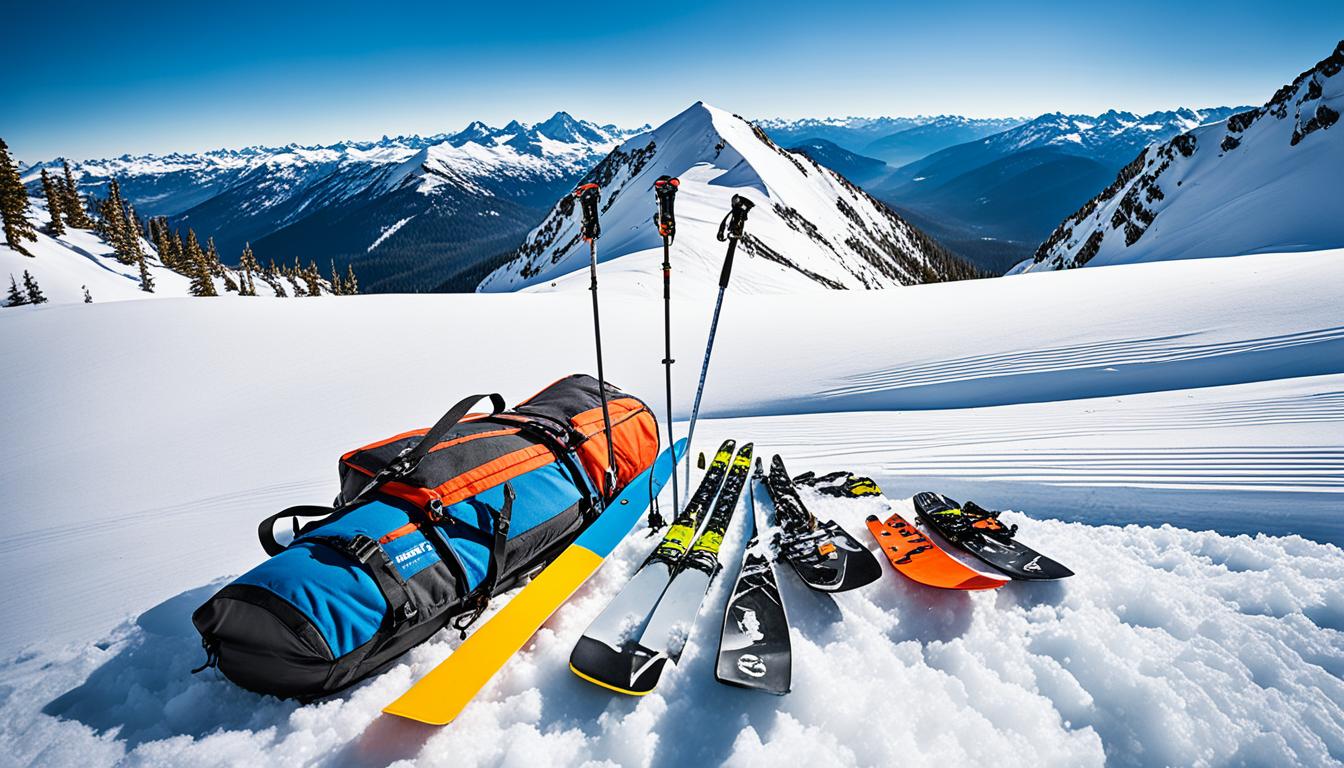Weather is key in backcountry skiing. It affects safety, conditions, and the fun. Reading weather patterns is vital for making smart choices before skiing. Temperature changes, snow, and big weather events can change how safe the snow is and the risk of an avalanche. This makes knowing the weather forecast and adjusting plans very important.
Key Takeaways:
- Interpreting weather patterns is crucial for backcountry skiing safety.
- Changes in temperature, snowfall, and extreme weather events can impact snowpack dynamics.
- Staying informed about the weather forecast is essential for adapting plans.
The Impact of Climate Change on Backcountry Skiing
Climate change is changing backcountry skiing a lot. The IPCC says skiers will face warmer days and less snow, along with more extreme weather. This shift, powered by global warming, changes everything about skiing. Snow layers and when avalanches happen are deeply altered, creating new dangers for skiers and the ski business.
The ski world is struggling due to these climate shifts. Less snow means fewer visitors for ski resorts. Also, wild weather makes it hard to plan, cutting short the ski season unpredictably. This affects the business and the experience skiers have.
Skiers are leading in fighting climate change because they see its effects up close. They care because the changing climate directly affects their favorite places to ski. This motivates them to speak up for the environment and work against climate change effects.
The ski industry is facing real risks from climate change, like less snow and severe weather. It’s key to tackle these issues now and fight for a better planet.
We have to act as climate change alters the world. It’s a signal for skiers, resorts, and nature protectors to join forces. By choosing green energy, using eco-friendly methods, and supporting laws to cut pollution, we can keep the backcountry skiing tradition alive. This way, the coming skiers can still enjoy the beauty of untouched snowy mountains.
The Passion and Magic of Skiing
Skiing goes beyond being a sport. It’s a deep passion that makes us fall in love with the mountains. Whether we’re smoothly skiing down prepared paths or exploring off the beaten tracks, skiing connects us with nature in both powerful and life-changing ways.
Exploring the backcountry, especially, lets us form a special relationship with the mountains. Here, amidst wild landscapes, our senses peak. We soak in every stunning detail— the quiet of fresh snow, the majesty of high peaks, and the chill of the mountain air. These moments together truly feel magical.
Embracing a Skiing Lifestyle
For those deeply into skiing, it’s not just a pastime; it’s their lifestyle. They might choose jobs aimed at feeding their skiing passion. And they’re ready to invest their time and resources into skiing. They put skiing first, sometimes ahead of personal relationships and financial comfort.
This zeal springs from the bond we share with the mountains. The majestic ranges become our everything-our play area, our refuge, and our muse. Their broadness and beauty give us peace and strength. So, we follow our skiing passion because these mountains inspire us more than anything else.
A Transformative Experience
Backcountry skiing deepens this bond further. It takes us into lands untouched, where we see the mountains in their full power. Every move we make tells a story of our resilience and will.
This kind of skiing changes us on a profound level. It makes us see the nature’s beauty and its vulnerability. We feel a deep respect for the environment. Our senses sharpen to notice the slightest changes in the weather and the harmony of life around us.
Backcountry skiing allows us to escape the noise and distractions of everyday life and reconnect with our true selves. It is in those quiet moments, surrounded by nature’s grandeur, that we find a sense of peace and harmony that is difficult to put into words.
We learn from backcountry skiing the value of living in the now. We see that true happiness lies in chasing what we love and forming bonds with the outdoors.
| Key Elements of Backcountry Skiing | Benefits |
|---|---|
| Immersive connection with nature | Enhanced appreciation for the environment |
| Physical challenge and personal growth | Improved fitness and self-confidence |
| Escape from the crowds | Peaceful and serene skiing experience |
| Opportunity for exploration and adventure | Discovery of hidden gems and new terrain |
| Connection with like-minded individuals | Building friendships and a sense of community |
Avalanches and Snowpack Dynamics
Avalanches pose a big risk in backcountry skiing. It’s crucial to know about snowpack dynamics to lower these dangers. The way snow piles up and forms layers affects how and when avalanches happen. These patterns also shape how safe the terrain is.
When going into avalanche territory, it’s vital to understand snow layers and their stability. Backcountry skiers must know how snow reacts to weather and slopes. Experts in avalanches deeply study snow behavior. This helps them check snow stability. They also offer key advice to skiers.
“Having a solid understanding of snowpack dynamics allows skiers to make informed decisions regarding terrain choices and the potential risks associated with backcountry skiing.”
Climate change makes the link between avalanches and snowpacks more complex. Rising temperatures and harsh weather can make snow layers less stable. This can lead to more avalanches. Skiers must think about climate change risks. It’s important for planning safe trips in the backcountry.
Anatomy of Snowpack Dynamics
To grasp snowpack dynamics and its role in avalanches, seeing the snowpack’s layout helps. The snowpack has layers from different weather events and snowfall. Each layer varies in how strong or cohesive it is.
Table: Snowpack Layer Characteristics
| Layer Name | Type | Characteristics |
|---|---|---|
| Surface Snow | New Snow | Soft, low cohesion, prone to wind drifting |
| Settled Snow | Old Snow | Higher cohesion, gradually transitioning towards a more stable layer |
| Crust | Formed by melting and refreezing | Varying strength and stability depending on the thickness and bonding to underlying layers |
| Depth Hoar | Large, faceted crystals that form in low-density snow layers | Poor bonding, weak layer prone to triggering avalanches |
Knowing about snow layers is key to understanding avalanche risks. Skiers must use weather data, the area’s terrain, and avalanche predictions to stay safe. This helps avoid the dangers of areas prone to avalanches.
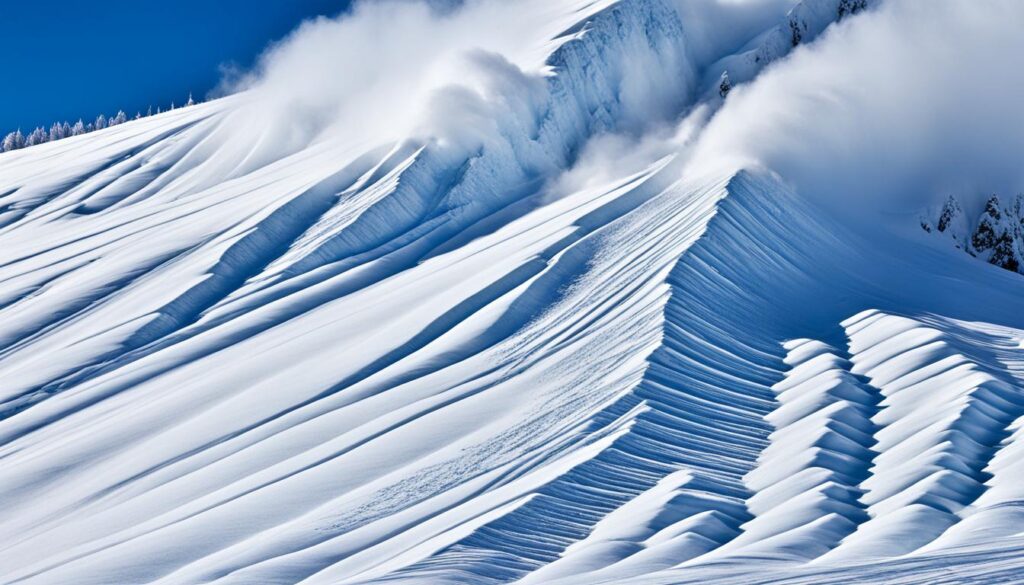
Knowing about snowpack and avalanche behavior is crucial for skiers. By staying informed, assessing the environment, and making smart choices, skiers can reduce avalanche dangers. This way, they can have fun in the backcountry without taking unnecessary risks.
Increased Avalanche Fatalities and Climate Change
The ski season of 2020/2021 saw a big increase in avalanche deaths in the US. This was due to a mix of reasons like the way snow piles up, climate change, and more people skiing off the beaten path. Such a dangerous mix of conditions stresses the need for skiers to be extra careful and take steps to lower their risk.
Climate change is making avalanches more likely and more dangerous. As the world warms, the snow becomes less steady, setting the stage for avalanches. Changes in how and when it snows also affect the snow’s stability. So, skiers need to watch out for these extra dangers and adjust how they ski.
“The link between climate change and more avalanches shows we really need to act. We have to fight climate change to keep backcountry skiing safe and reduce the risk of avalanches.” – Expert
Heading into the backcountry has its own set of dangers. Skiers need to keep learning and using new skills to deal with different kinds of snow. Knowing the weather, checking the snow situation, and following avalanche warnings are key. Getting proper avalanche training and making sure you have the right safety gear are necessary steps. It’s also smart to ski with others who know what they’re doing.
In the backcountry, making smart choices and being careful while moving around are a must. Pick your route with care, steer clear of places where avalanches can happen, and watch for any signs of danger. With the right knowledge, preparation, and awareness, skiers can lower the risks and still have fun exploring the wild places on skis while keeping safe.
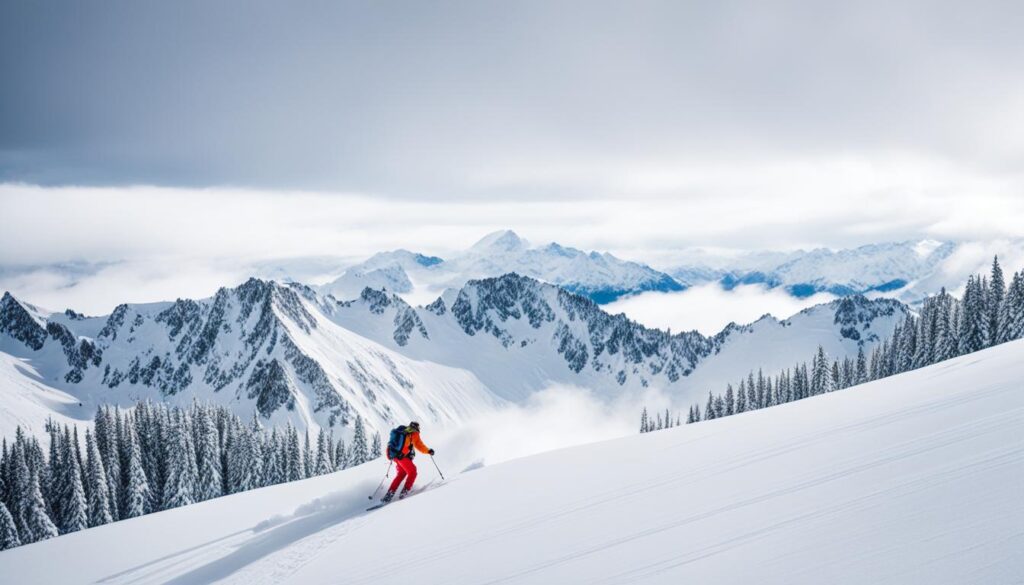
Skiing as an Inspiration for Environmental Stewardship
Skiing is far beyond a sport; it motivates us to care for the environment. As skiers, we love the mountains deeply. We see how crucial it is to keep their natural balance to keep skiing. This link drives us to fight against climate change in our community.
I think skiing helps us see the effects of a changing climate. We notice when it’s warmer, snow falls less, and storms happen more. These signs show us the real threats. Being on the slopes makes us realize the ski world is at risk because of these changes.
So, many skiers now push for actions that fight climate change and aim for green efforts in skiing. We admit that skiing also adds to the problem but believe we can change this. By choosing to back eco-friendly ski resorts, we aim for a future with skiing and nature still intact.
Skiing has the power to inspire us to take action and make a difference. It reminds us of the beauty and fragility of the natural world, fueling our passion to protect it.
Quotes:
“Skiing allows us to experience firsthand the vulnerabilities of the ski industry and the delicate balance of snowpack dynamics.” – Jake Thompson, Backcountry Skier
“As skiers, we have a responsibility to protect the mountains and the environment. It’s not just about the sport; it’s about preserving the natural beauty that brings us so much joy.” – Rebecca Davis, Environmental Advocate
Why the Ski Industry’s Role in Climate Change Matters:
- The ski industry is a big part of the problem with emissions from power use, snow making, and travel.
- Hotter temperatures and less snow directly threaten ski resorts and their future.
- Skiers need healthy natural systems to keep enjoying the sport, which is why we must act.
Advocating for Change:
- Back ski resorts making green choices like using renewable energy and reducing waste.
- Make smart decisions in how we ski, like traveling with less impact and choosing eco gear.
- Teach fellow skiers why climate change matters and how we can be part of the solution.
In the end, skiing can lead us to care for the planet more. By realizing the impact and choosing green, we can reduce harm. This way, we join the fight to make our world a better place for all.
Backcountry Skiing and Personal Decision-Making
In backcountry skiing, making the right choices means using a scientific method. Skiers should gather data, look at avalanche forecasts, and understand the snow’s stability. This creates a starting point for their decisions.
When skiing, picking out important details is key. They need to know the difference between obvious and subtle clues. Cracks and snow that falls suddenly are big signs of danger. They need careful attention and affect which routes to take. Yet, the way snow layers are arranged and long-term weather can help track and plan adventures better.
“The scientific approach to backcountry skiing involves not only understanding the immediate signs of danger but also recognizing the subtle patterns that can affect long-term safety.”
This method helps skiers focus on safety for themselves and their group. It involves looking closely at all the available data. This allows them to make decisions based on real facts rather than guesswork.
Benefits of a Systematic Decision-Making Process
Having a clear system when making decisions in backcountry skiing is very beneficial. It helps skiers see risks and make choices that keep them safe. By looking at many sources, skiers can understand the current dangers, foresee problems, and change their plans as needed.
Also, it helps skiers notice patterns over time. This lets them predict future dangers better. Being ready in advance helps avoid surprises from sudden weather changes or unstable snow.
Guidelines for Prioritizing Information
Choosing what’s important in the backcountry can be overwhelming. It’s important to know what to focus on. Here are some tips for sorting through information:
- Look for obvious signs of danger. This includes cracking, collapsing, or recent avalanches. These are urgent and need immediate action.
- Understand how the snow is stacked and its stability. Knowing the snow’s structure helps judge avalanche risks.
- Keep an eye on the weather over time. Changes in temperature, snow, and wind affect the snow’s stability.
- Stay updated on avalanche forecasts and what others see in the backcountry. This information gives insights into current risks.
By using these steps, skiers can focus on the important information. This helps them make safer decisions and enjoy the backcountry more.
Conclusion
Weather knowledge is key for backcountry skiers. They should keep an eye on forecasts and understand weather signs. This helps make smart choices and adjust plans as needed.
Climate change poses big problems for skiing. This makes being environmentally aware and advocating for change crucial in the skiing world. It’s our duty as skiers to keep everyone safe by using important info, making logical decisions, and following safety rules.
Good weather knowledge and smart decision-making are vital for a great time in the backcountry. With a sharp eye and constantly improving skills, we can tackle any challenge. Always remember that nature is powerful and ever-changing. Staying safe, respecting nature, and facing issues head-on lets us experience the joy and freedom of backcountry skiing with fewer dangers.
To sum up, understanding weather and using a scientific mindset are crucial for backcountry skiing. Grasping how weather affects skiing, acknowledging climate issues, and using safety steps help make our skiing adventures thrilling yet responsible. Let’s love the mountains, support the environment, and safeguard this amazing sport for those who come after us.
FAQ
How does weather impact backcountry skiing?
Weather is key for backcountry skiing. It influences the snow, safety, and how much fun you have. Changes in temperature and snowfall really matter. They can change the risk of avalanches. Skiers need to watch the weather forecast and change their plans if needed.
What is the impact of climate change on backcountry skiing?
Climate change affects backcountry skiing a lot. It brings warmer days, less snow, and more extreme weather. These changes make the snow and avalanches unpredictable. This is hard for the ski industry and it changes how long or when you can ski.
What makes backcountry skiing a transformative experience?
Backcountry skiing connects you deeply with nature. Skiers often work odd jobs to keep skiing. They might not have a lot of money or time for normal life. This connection offers a special feeling of love and awe for the world around them.
What are the risks of avalanches in backcountry skiing?
Avalanches are a big danger. They depend on the snow layers and the weather. Skiers must know how to read the snow and avoid risky places.
How has climate change affected avalanche fatalities in recent ski seasons?
In the 2020/2021 season, the US saw more avalanche deaths. Climate change, snow layers, and more people going into the backcountry all played a role. Skiers need to be very safe and prepared.
How does skiing inspire environmental stewardship?
Love for skiing often leads to caring about the planet. Skiers learn about climate change and start to fight for the environment. This sport can inspire people to push for green practices in skiing.
How can skiers make informed decisions in the backcountry?
Skiers should approach their decisions like they’re running a science experiment. They guess what might happen based on forecasts and their knowledge. Then, picking safety first, they choose their path carefully.
What is the importance of weather awareness in backcountry skiing?
Knowing the weather well is critical for backcountry skiing. It affects the snow and riks of avalanches. Skiers need to keep an eye on the forecasts and be ready to change their plans. This makes sure they stay safe while having fun.

